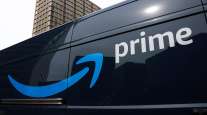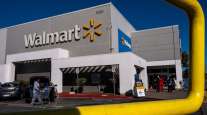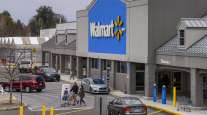Bloomberg News
Startup Couriers Snatch Toehold in Biggest Shake-Up of E-Commerce Era

[Stay on top of transportation news: Get TTNews in your inbox.]
Surging e-commerce is generating more package deliveries than giant couriers can handle, clogging retailers’ logistical pipelines and frustrating consumers. But the logjam is spawning startups with new ways of speeding deliveries.
Smaller haulers are innovating with crowdsourced networks using little more than smartphones and sport utility vehicles. Gig drivers for a startup called Veho Tech Inc. scan packages with their cellphones, load them in their own cars — a motley assortment of crossovers and sedans with spacious trunks — and hit the road within minutes to meet their cargo’s next-day delivery deadlines.
The drivers check an app for any special instructions at each stop and take a doorstep snapshot of every delivered package. Shippers and receivers can both access Veho’s real-time chats with customer service agents in case of any snags. While the company hasn’t disclosed its growth in sales or package volume, it expects to expand to 20 major cities by year-end, up from 10 now and three in January.
“Our focus is working with e-commerce companies that put the customer in the center,” Itamar Zur, Veho’s CEO, said at a company warehouse in Grand Prairie, Texas. “They understand that when their customer is happy through the delivery, that customer will come back.”

Zur
Veho and other startups such as AxleHire, Dropoff Inc. and Roadie are essentially auditioning for an outsize role in the biggest makeover of the delivery business since FedEx Corp. started flying packages overnight in 1973. They’re too small to be a direct threat to FedEx and UPS Inc., but they’re poised to reset consumer expectations for delivery speeds and service while the big couriers struggle to keep up with soaring volumes spurred by online shopping.
The startups have slightly different approaches, but the basic formula works like this: Retailers or warehouse operators contract with the companies to deliver their products to homes. Gig workers pick up the shipments at a distribution point and carry them to the final location. Customers get tracking information all along the route but may have no idea their packages are being transferred among multiple parties, including independent freelancers.
‘Getting the Box’
The pandemic accelerated demand for home deliveries last year to the point that the parcel giants raised prices and turned away some packages from large retailers. The capacity crunch in the all-important link between retailers and customers has made shippers less hesitant to try new offerings for last-mile delivery.
“More and more, you’re going to see companies begin to realize that part of the experience their customers have isn’t just opening the box, it’s getting the box,” said Rob Hayes, who headed up First Round Capital’s early 2010 investment in Uber Technologies Inc.
Hayes is also backing Boulder, Colo.-based Veho, which Zur co-founded after his team’s package-delivery concept won the top prize at Harvard Business School’s New Venture Competition in 2017.

Could this be the trucking industry’s roaring '20s? Business is booming, thanks, in part, to a slew of innovative technologies. With host Mike Freeze, we begin to wonder what’s next? Hear a snippet above, and get the full program by going to RoadSigns.TTNews.com.
U.S. last-mile delivery startups attracted about $144.5 million this year through early June, according to Crunchbase. That put the sector on track to surpass the $211.8 million it raised during last year as a whole and the $70.6 million from 2019. A total of more than 70 startups got funding, a sign of how much easier it has become to muscle into the business.
FedEx and UPS are increasingly focusing on the final consumer, too. When UPS CEO Carol Tome took the reins a little more than a year ago, she found that sales were growing but service wasn’t getting any better.
“And ‘better’ meant improving the customer experience, not just from the shipper — the retailer — but all the way to the recipient because that end-to-end experience is so very important as you see it shift more to the residential deliveries,” Tome said at a National Retail Federation conference on June 22.
Just a Blip
Startup couriers are just a blip on the radar screen for the giants, which on average deliver a combined 40 million packages a day. Any slowdown in demand could upend the newcomers, which typically don’t own hard assets like aircraft or trucks.
But residential deliveries are widely expected to continue growing even as vaccines enable more people to emerge from their homes and shop at brick-and-mortar establishments. Armed with technology that matches or surpasses systems that took UPS and FedEx years to develop, the startups are making the most of growing demand for same-day and short-distance delivery. UPS, for example, is working with Roadie to test same-day drop-offs and owns a stake in the startup.
Above all, the new entrants vying for the package-delivery gold rush are winning business by adapting to the changing needs of the retail industry. Some retailers are seeking alternatives to Amazon.com Inc. and its ubiquitous gray and blue delivery vans, which can be expensive to use and force sellers to give up some control over their goods and data. Meanwhile, businesses are splitting up their inventory into multiple warehouses to enable speedier deliveries, opening the door to smaller players.
“Now, it’s not a single warehouse in the middle of the country that can service all 48 states and internationally,” said Brian Lemerise, chief operating officer at Quiet 3PF, a third-party logistics provider that works with such retailers as American Eagle Outfitters Inc. and Mack Weldon Inc.
Custom Inserts
At a Quiet 3PF warehouse in Dallas, orders made as late as 4 p.m. are packed with custom inserts from retailers. They are then handed over for next-day local delivery by AxleHire, a San Francisco-based courier that uses gig drivers and operates in about 10 cities, with plans to add three or four more this year.
“Our goal here is to build a premier national final-mile delivery service,” said AxleHire CEO Adam Bryant, a former Tesla Inc. engineer turned venture fund partner. “We’ll be in every major metro, providing a one-stop-shop delivery service that’s out of our facilities, a client’s facility or straight from the store.”

In California, Mack Weldon opened an additional fulfillment center through Quiet for customer deliveries in the Western U.S., said Brian Berger, CEO of the retailer, which also works with UPS and FedEx.
Quiet also helped American Eagle add four regional fulfillment centers last year in addition to its two large distribution centers. That helped lower delivery costs, boost sales and reduce inventory, said Shekar Natarajan, chief of the global supply chain at the retailer, which also uses a mix of couriers.
“The results of our strategy is showing up in many, many places,”Natarajan said.
UPS ranks No. 1 and FedEx No. 2 on the Transport Topics Top 100 list of the largest for-hire carriers in North America.
— With assistance from Marie Monteleone.
Want more news? Listen to today's daily briefing below or go here for more info:




